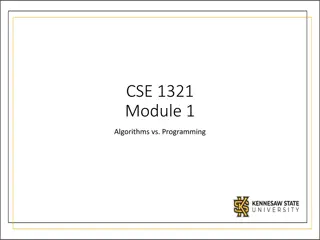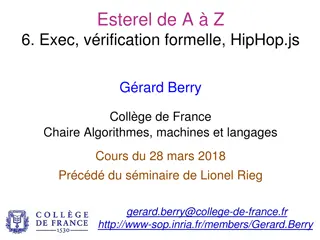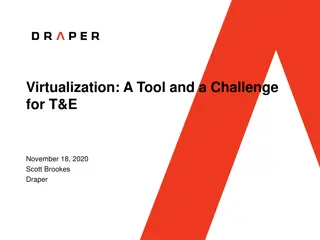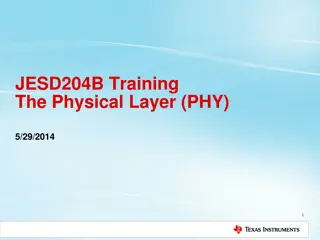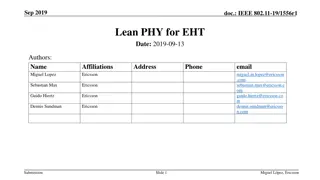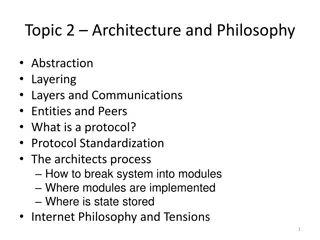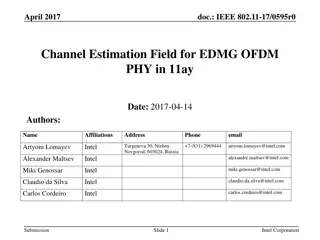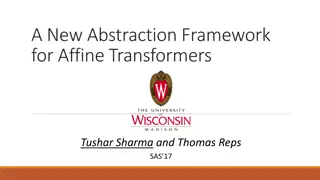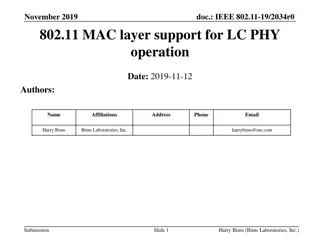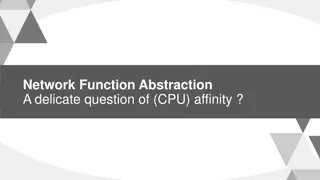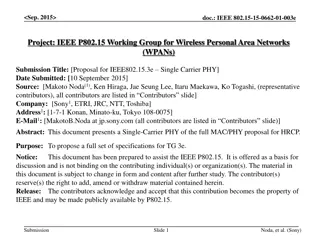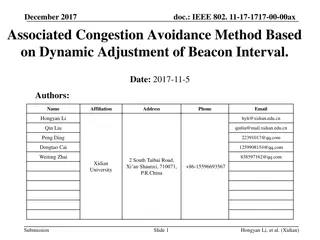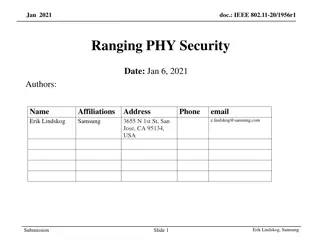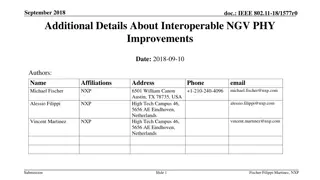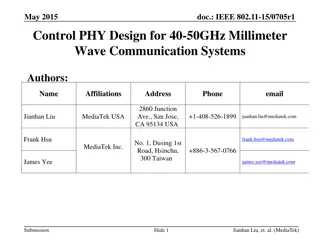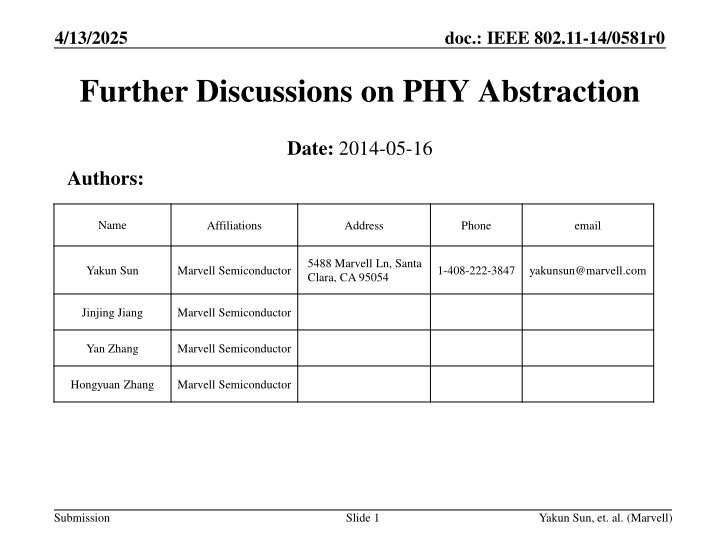
Mutual Information-Based ESM for Effective SINR Mapping in IEEE 802.11-14/0581r0
Explore the discussion on PHY abstraction and effective SINR mapping in the IEEE 802.11-14/0581r0 document dated Jan. 2014. The document delves into topics like the modeling of SINR, mutual information, channel types, RBIR, and MMIB-based abstraction. Discover the benefits of MIESM, channel independence, and robustness to frequency selectivity. Gain insights into implementing ESM and predicting PER across different channel scenarios.
Download Presentation

Please find below an Image/Link to download the presentation.
The content on the website is provided AS IS for your information and personal use only. It may not be sold, licensed, or shared on other websites without obtaining consent from the author. If you encounter any issues during the download, it is possible that the publisher has removed the file from their server.
You are allowed to download the files provided on this website for personal or commercial use, subject to the condition that they are used lawfully. All files are the property of their respective owners.
The content on the website is provided AS IS for your information and personal use only. It may not be sold, licensed, or shared on other websites without obtaining consent from the author.
E N D
Presentation Transcript
4/13/2025 doc.: IEEE 802.11-14/0581r0 Further Discussions on PHY Abstraction Date: 2014-05-16 Authors: Name Affiliations Address Phone email 5488 Marvell Ln, Santa Clara, CA 95054 Yakun Sun Marvell Semiconductor 1-408-222-3847 yakunsun@marvell.com Jinjing Jiang Marvell Semiconductor Yan Zhang Marvell Semiconductor Hongyuan Zhang Marvell Semiconductor Submission Slide 1 Yakun Sun, et. al. (Marvell)
doc.: IEEE 802.11-14/0581r0 Jan. 2014 ESM for PHY Abstraction Effective SINR is an average mapped equalizer-output SINR over all subcarriers. Hedge factors alpha and beta can be used to calibrate and compensate any residual errors, if necessary. 1 N N SINR = 1 SINR n eff = 1 n OFDM transmission is modeled as an AWGN channel with one effective SINR. Submission Slide 2 Yakun Sun, et. Al.
Jan. 2014 doc.: IEEE 802.11-14/0581r0 Effective SINR Mapping Functions PHY Abstract SINR Mapping ( ) x ( ) = exp x EESM Exponential mapping ( ) Mutual information assuming CM 1 M M M 2 ( ) x ( ) 2 = + log log exp M E U x s s U CM based RBIR 2 2 U k m = = 1 1 m k ( ) M 2 ( ) + BICM based RBIR Mutual information assuming BICM exp x s s U log log M M k 1 M 1 2 2 ( ) x ( ) = = = ; log log 1 k I b Y M E ( ) 2 2 i U 2 ( ) + = = = i b exp 1 1 0 i i b x s s U s S k i b s S k Mutual information by LLR channels ( ) 1 M M K ( ) x ( ) x = = MMIB I a J c x b k k i = = 1 1 i k Submission Slide 3 Yakun Sun, et. Al.
4/13/2025 doc.: IEEE 802.11-14/0581r0 Benefit of MIESM Mutual information based ESM (MIESM) has been proposed for PHY abstraction [1,2,3]. RBIR and MMIB are basically equivalent, just two approaches to compute the mutual information conditioned on the modulation. MIESM based effective SNR vs. PER performance is channel type independent. 1 set of PER look up tables is enough, very easy to implement in SLS highly extensible for any future technologies (and the associated effective channels/scenarios) Very easy to calibrate across companies (no or minimal number of tuning parameters) Minimal effort in implementing MIESM. Merely a lookup table (RBIR) or a closed form (MMIB) for a packet (with a MCS). Implementation loss can be included in per tone SINR calculation After a modeling of SINR loss, the procedure of ESM is identical as ideal receiver. enable using ideal receiver performance as PER LUT baseline Submission Slide 4 Yakun Sun, et. al. (Marvell)
4/13/2025 doc.: IEEE 802.11-14/0581r0 Independence on Channel Type Channels simulated: AWGN, B_LOS/NLOS, D_NLOS, F_NLOS An extreme channel type X : Equal power PDP with the delay spread of channel F (600ns). 20MHz, 2.4GHz, 1x1, 8000 bits per packet. Ideal channel estimation PHY-abstraction: RBIR-BICM based The results of RBIR-CM/MMIB based PHY abstraction (not plotted) are very close. Effective SNR vs. PER for different channel types are within a very small range. RBIR-based PHY abstraction is robust to channel frequency selectivity (and frequency selective interference). Using a universal (AWGN) curves to predict PER for various types of channels are reliable. Submission Slide 5 Yakun Sun, et. al. (Marvell)
4/13/2025 doc.: IEEE 802.11-14/0581r0 Independence on Channel Type (2) 20MHz, 1x1, LDPC 0 10 -1 10 AWGN (black) D_NLOS(blue) -2 PER 10 F_NLOS(red) -3 10 X_NLOS (green) B_LOS (cyan) B_NLOS (magenta) -4 10 -5 0 5 10 15 20 25 Effective SNR (dB) Effective SNR vs. PER for a large variety of channel types (AWGN, B-LOS/NLOS, D/F/X-NLOS) are almost identical. Submission Slide 6 Yakun Sun, et. al. (Marvell)
4/13/2025 doc.: IEEE 802.11-14/0581r0 Independence on Channel Type (2) 20MHz, 1x1, BCC 0 10 AWGN (black) -1 10 D_NLOS(blue) PER F_NLOS(red) -2 10 B_LOS (cyan) B_NLOS (magenta) X_NLOS (green) -3 10 -5 0 5 10 15 20 25 30 Effective SNR (dB) Effective SNR vs. PER for a large variety of channel types (AWGN, B-LOS/NLOS, D/F/X-NLOS) spans 0.5dB 0.2dB. Submission Slide 7 Yakun Sun, et. al. (Marvell)
4/13/2025 doc.: IEEE 802.11-14/0581r0 Frequency Selective Interference Frequency selective interference can be experienced in OBSS scenarios and caused by potential 11ax technologies such as OFDMA. PHY abstraction should be accurate and robust in this case. Infinite number of possible interference levels, cannot rely on tune-up per case. Interference Level Freq Submission Slide 8 Yakun Sun, et. al. (Marvell)
4/13/2025 doc.: IEEE 802.11-14/0581r0 Freq Selective Interference 10dB Rise Assume of tones are under 10dB stronger interference. AWGN, BCC, MCS 0/7 Compare effective SNR vs. PER results against those of various channel types in the previous results. Interference Level 10dB freq 0.25*Ntone 0.75*Ntone Submission Slide 9 Yakun Sun, et. al. (Marvell)
4/13/2025 doc.: IEEE 802.11-14/0581r0 Robustness to Freq Selective Interference 20MHz, 1x1, BCC 0 10 Freq Selective Interference, MCS0 -1 10 PER Freq Selective Interference, MCS7 -2 10 -3 10 -5 0 5 10 15 20 25 30 Effective SNR (dB) Effective SNR vs. PER for 10dB interference rise well aligned with results of various channel types w/ flat noise. MIESM is accurate and robust to the frequency selective interference. Submission Slide 10 Yakun Sun, et. al. (Marvell)
4/13/2025 doc.: IEEE 802.11-14/0581r0 PER Prediction TGac channel: D-NLOS, F-NLOS, B-LOS Channel realizations in PER prediction simulations are independent with the ones used for effective SNR vs. PER lookup table generation. Case 1: one randomly selected (and fixed) channel realization Case 2: 4000 channel realizations PER is obtained for each SNR point in two ways: Simulated: count by decoding errors Predicted: predict PER by PHY abstraction. For each channel realization: Calculate a PER based on effective SNR (from RBIR mapping), Then flip a coin to decide if the packet is correctly received based on the calculated PER. (Namely, draw a random variable x ~U[0,1]; packet fails if x < PER.) PER = total number of failed packets/total number of packets. Predicted PER is very close to simulated PER. Using RBIR and AWGN curves to predict PER for various types of channels are reliable. Submission Slide 11 Yakun Sun, et. al. (Marvell)
4/13/2025 doc.: IEEE 802.11-14/0581r0 Case 1: A Random/Fixed Channel Realization (D_NLOS) 1x1 D-NLOS, 1 fixed channel realization, LDPC 1x1 D-NLOS, 1 fixed channel realization, BCC 0 0 10 10 -1 -1 10 10 -2 -2 PER PER 10 10 -3 -3 10 10 Simulated Predicted Simulated Predicted -4 -4 10 10 -10 -5 0 5 10 15 20 25 -10 -5 0 5 10 15 20 25 30 SNR (dB) SNR (dB) For an arbitrary channel realization, PER prediction by RBIR-based PHY prediction is accurate for LDPC and less than 0.3dB offset (PER=10%) for BCC. Submission Slide 12 Yakun Sun, et. al. (Marvell)
May 2014 doc.: IEEE 802.11-14/0581r0 Case 1: Statistics on More Random/Fixed Channel Realizations (D_NLOS) Okay, we can be lucky in the previous specific random and fixed channel realization. 100 more tests on random/fixed channel realizations. Look at the SNR offset @ PER = 10% for each channel realization. MCS 0 1 2 3 4 5 6 7 8 9 Mean (dB) 0.01 -0.02 -0.01 0.01 -0.05 -0.11 -0.03 0.07 0.07 0.01 LDPC Var (dB) 0.19 0.15 0.20 0.10 0.18 0.12 0.11 0.19 0.18 0.12 MCS 0 1 2 3 4 5 6 7 8 9 Mean (dB) -0.35 -0.42 -0.39 -0.21 -0.31 -0.17 -0.13 -0.41 -0.13 -0.29 BCC Var (dB) 0.74 0.73 0.97 0.51 0.89 0.50 0.81 0.78 0.49 0.60 Submission Slide 13 Yakun Sun, et. al. (Marvell)
4/13/2025 doc.: IEEE 802.11-14/0581r0 Case 2: 4000 Channel Realizations (D_NLOS) 1x1 D-NLOS, LDPC Simulated Predicted 1x1 D-NLOS, BCC 0 0 10 10 Simulated Predicted -1 10 -1 10 -2 PER PER 10 -2 10 -3 10 -4 -3 10 10 -10 0 10 20 30 40 50 -10 0 10 20 30 40 50 SNR (dB) SNR (dB) PER prediction by RBIR-based PHY prediction is accurate for LDPC and less than 0.5dB offset (PER=10%) for BCC over channel realizations. Submission Slide 14 Yakun Sun, et. al. (Marvell)
4/13/2025 doc.: IEEE 802.11-14/0581r0 Case 2: 4000 Channel Realizations (F_NLOS) 1x1 F-NLOS, BCC 1x1 F-NLOS, LDPC 0 0 10 10 -1 10 -1 10 -2 PER PER 10 -2 10 -3 10 Simulated Predicted Simulated Predicted -4 -3 10 10 -10 -5 0 5 10 15 20 25 30 35 40 -10 -5 0 5 10 15 20 25 30 35 40 SNR (dB) SNR (dB) Same observation as D-NLOS channel Submission Slide 15 Yakun Sun, et. al. (Marvell)
4/13/2025 doc.: IEEE 802.11-14/0581r0 Case 2: 4000 Channel Realizations (B_LOS) 1x1 B-LOS, LDPC Simulated Predicted 1x1 B-LOS, BCC 0 0 10 10 Simulated Predicted -1 -1 10 10 PER PER -2 -2 10 10 -3 -3 10 10 -10 0 10 20 30 40 50 -10 0 10 20 30 40 50 SNR (dB) SNR (dB) Similar observation as D-NLOS channel (even less offset for BCC) Submission Slide 16 Yakun Sun, et. al. (Marvell)
4/13/2025 doc.: IEEE 802.11-14/0581r0 Conclusions MIESM-based PHY abstraction is independent to channel types/interference scenarios. AWGN-based SNR vs. PER lookup table can accurately predict PER for various channel types. Submission Slide 17 Yakun Sun, et. al. (Marvell)
4/13/2025 doc.: IEEE 802.11-14/0581r0 Reference [1] 11-14-0117-00-0hew-PHY-abstraction-for-HEW-system-level-simulation [2] 11-13-1131-00-0hew-phyabstraction-for-hew-system-level-simulation [3] 11-14-0353-00-0hew-suggestion-on-phy-abstraction-for-evaluation- methodology [4] 11-14-0043-02-0hew-PHY-abstraction-in-system-level-simulation-for- HEW-study [5] 11-14-0335-00-0hew-instantenous-sinr-calibration-for-system-simulation Submission Slide 18 Yakun Sun, et. al. (Marvell)

